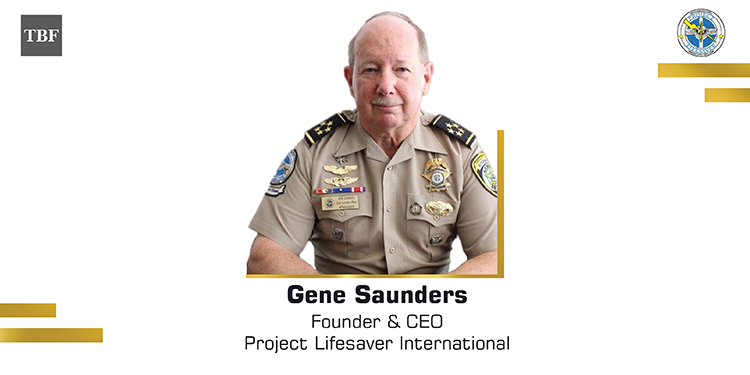Served 33 years with the Chesapeake Police Department, serving in Patrol, Vice, Narcotics, Detectives, and Training, Gene Saunders, Founder and CEO of Project Lifesaver International, recognized internationally as an expert and the father of radio tracking recovery of persons at risk. Mr. Saunders has written several pieces about wandering for periodicals and has been on a variety of local, national, and international radio and television shows. CBS Early Show, Extreme Makeover Home Edition, Living the Life, Fox News, The Discovery Channel, CNN News, The Daily Buzz, and William Shatner’s “Moving America Forward” are just a few examples.
Mr. Saunders had served in each of these units’ line functions and command components. In 1974, he co-founded the Special Weapons and Tactics team, and during the next 23 years, he served as tactical commander and commander on over 800 operations. He served as the lead investigator on a number of multi-state, international narcotics and organized criminal conspiracy investigations. During the 1996 Olympics in Atlanta, Georgia, he also worked as a shift commander for the Olympic Security Team at the soccer venue.
Mr. Saunders retired as a Captain in 2001 after serving in the National Guard and State Defense Force in leadership and command capacities in infantry, airborne, and ranger units. Mr. Saunders is a certified instructor in Pursuit Driving, Firearms, Special Operations, Raid Planning, General Law Enforcement, and Search and Rescue. He also served in the US Air Force Auxiliary (Civil Air Patrol) as a Senior Squadron (Ranger) commander and for 5 years as Commandant of the Middle East Region Staff College. Mr. Saunders is a volunteer helicopter flight officer with the Virginia Beach Police Department and has skydived for numerous years.
Project Lifesaver has been involved in a number of legislative measures to address the problem of straying and has earned a number of awards as a result of its work. Under Mr. Saunders’s leadership, the company has reached almost 1,700 member agencies in 50 states, 9 provinces in Canada and is working with Western Australia. Its members have accounted for over 3,800 successful rescues.
Project Lifesaver
Project Lifesaver, based in Chesapeake, Virginia, is a 501(c)(3) community-based public safety non-profit that provides law enforcement, fire/rescue, and caregivers with a program designed to protect and, when necessary, quickly locate individuals with cognitive disorders who are prone to the life-threatening behavior of wandering. The association between cognitive disorders and roaming was used to assess the need for this program. The program has developed from a regional program to a program known globally as a proven and practical technique for “bringing loved ones home” because of the enormous growth in cognitive disorders since the organization’s founding.
Project Lifesaver was the first to deploy such locating tactics to help in the search and rescue of people, and it is the nation’s most frequently used and proven most successful program for protecting “At Risk” groups in communities.
The initiative was designed to deliberately integrate cutting-edge locating technology, cutting-edge search and rescue techniques, and community policing training that trained first responders on cognitive problems. The time it takes to find approved Project Lifesaver agencies has been cut in half, from hours to days. Project Lifesaver agencies recover in 30 minutes on average, which is 95 percent faster than typical operations without Project Lifesaver.
The Process of Saving Lives
Public safety authorities manage the Project Lifesaver Program at the local level. When a government agency agrees to adopt the program, Project Lifesaver International provides the required technology and training to all participants. The training covers how to utilize the equipment, how to apply the program’s strategic tactics, and community policing classes that teach a basic knowledge of cognitive problems so that officers may better understand the actions of people with such illnesses. The use of the PLS Database, a helpful resource supplied to member agencies at no cost, is also covered during training. Certification requires the completion of training. After becoming accredited, an agency can begin recruiting customers for their local program.
The strategy employs tried-and-true radio technology as well as carefully trained search and rescue crews. Project Lifesaver participants wear a tiny transmitter on their wrist or ankle that produces a unique frequency signal. When a Project Lifesaver client goes away, the caregiver alerts their local Project Lifesaver organization, and a trained emergency crew is dispatched to the wanderer’s location. The first responders will then utilize the client’s unique frequency to pinpoint the individual’s location. The expertise gained from community policing training is most useful in this case, since first responders will know how to approach the client after they have been located and will be able to return them to safety.
Keeping Motivation High
The Project Lifesaver Program provides radio-tracking equipment as well as program and approach training. We also educate each agency on the various conditions, such as Alzheimer’s, Autism, and others, so that they are aware of the people they will be dealing with and how to communicate with them.
Mr. Saunders says, “Keeping up the morale and motivation results in good work habits and production.” He further adds that the team at the Project Lifesaver Program will keep improving its services and equipment, staying abreast of the disorder they are dealing with and the changes in public safety culture. He states, “We believe our service will continue to expand, especially in other countries where the problems we deal with the increase.”










